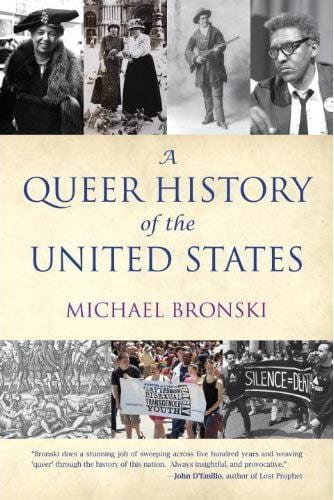In his newest book, A Queer History of the United States, Michael Bronski undertakes the herculean task of condensing nearly 500 years of queer American cultural, social and political history into one volume.
Bronski is a senior lecturer in women’s, gender and Jewish studies at Dartmouth College in New Hampshire and the author of a shelf of provocative books. In A Queer History of the United States he uses shifts in literary, cultural and philosophical trends to track the sociopolitical role queer people have played in the construction of the American project.
Bronski’s insights are wide-ranging, and he uses stylish prose to craft amusing and instructive descriptions of a plethora of colourful characters. His cultural cartography extends from the Molly House to the bathhouse, charting America’s sexual glasnost, from 1492 through the American Revolution, the growth of its cities, the Wild West, two world wars, Stonewall, the sexual revolution and AIDS. He also exposes the puritanical moralism that reached its contemporary apotheosis in the horror-show visage of the ghastly Anita Bryant.
Xtra: You’ve written that you were not simply attempting to write the history of the contribution of queer folk to American history, but rather to show that queer history is American history. In this light, do you consider this work a political act of queer revisionism?
Bronski: I am more comfortable thinking of this project as a “queer investigation.” Covering 500 years in fewer than 300 pages is going to leave myriad gaps and exclusions. That said, I do think the book is extremely political in that it attempts to locate how “queer” and “American” are inextricably intertwined.
Xtra: A Queer History of the United States functions as a cultural, sociological and political history. Of these three, which sphere do you feel made/makes the greatest contribution to queer rights?
Bronski: I think that depends on how you define “queer rights.” If you are looking at equality under the law and overturning discriminatory legislation, then certainly the political lens is important. But if you argue that “queer rights” include garnering respect and exerting, often widespread, influence, then I think the cultural influence is stronger. Look at it this way: we are still fighting for what seems to be a simple case of legal equality in the battle for same-sex marriage, and while we are winning very slowly, it is an uphill battle. Yet Lady Gaga, who has deep roots in gay culture and has done more to bring the idea of LGBT equality to millions of people, is a stupendous success. Which is stronger? Clearly Lady Gaga. Which is more important? They both are, but change does not only happen in a single venue, and we have to understand it in a collaborative context. That is how progress works, and to slight one of these avenues in favour of another is misleading.
Xtra: A refreshing aspect of the book is that you occasionally inject your personal politics. You cite Emily Dickinson: “Tell all the truth, but tell it slant.” What is your political slant?
Bronski: I have a long history of political involvement. I joined the Gay Liberation Front in 1969, right after the Stonewall riots, so the book, obviously, reflects this. Some people have been surprised that the book is not more about the gay and lesbian movement, but the movement is maybe 60 years old – a very small segment of the history of queer people in America. I have worked in the gay movement since 1960 and am indebted to it in so many ways, but it is only one aspect – and a relatively small one over 500 years – of how people’s lives have changed.
Xtra: For you, how important is it for marginalized people – and, in this case especially, queer youth – to have a sense of their history?
Bronski: This is, in the US, a complicated question. Of course queer youth need to have a firm, complicated sense of LGBT history. But they also need a firm sense of US history as well… Queer history is American history, and young queer people need to know both. When I was writing the book I was continually trying to place the events, people and ideas that were specifically queer in broader historical contexts, and I do think that anyone who reads the book will come away [with] a grasp of traditional US history with my particular slant on finding, exposing and highlighting the queer aspect of it.
Xtra: What else are you hoping your readers will take away from A Queer History of the United States?
Bronski: Change is possible, and we as humans are capable of it. So if there is a lesson in the book it is that this is our world and our lives, and we can make and remake it any way we choose.
* * *
It is likely that some will criticize Bronski for attempting to take stock of the vast width and breadth of queer American history in one short text, but this criticism misses the point of his effort. The primary achievement here is the presentation of a tantalizing survey that spans the greater arc of 500 years of queer experience in America. It is not a definitive history; such an effort would easily fill a library.

 Why you can trust Xtra
Why you can trust Xtra


